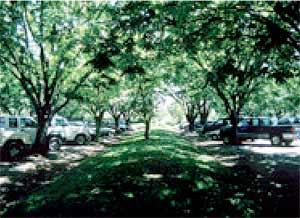Using Trees and Vegetation to Reduce Heat Islands
Trees and other plants help cool the environment, making vegetation a simple and effective way to reduce urban heat islands.
Trees and vegetation lower surface and air temperatures by providing shade and through evapotranspiration. Shaded surfaces, for example, may be 20–45°F (11–25°C) cooler than the peak temperatures of unshaded materials.1 Evapotranspiration, alone or in combination with shading, can help reduce peak summer temperatures by 2–9°F (1–5°C).2,3
Trees and vegetation are most useful as a mitigation strategy when planted in strategic locations around buildings or to shade pavement in parking lots and on streets. Researchers have found that planting deciduous trees or vines to the west is typically most effective for cooling a building, especially if they shade windows and part of the building’s roof.
Benefits and Costs
The use of trees and vegetation in the urban environment brings benefits beyond mitigating urban heat islands including:
- Reduced energy use: Trees and vegetation that directly shade buildings decrease demand for air conditioning.
- Improved air quality and lower greenhouse gas emissions: By reducing energy demand, trees and vegetation decrease the production of associated air pollution and greenhouse gas emissions. They also remove air pollutants and store and sequester carbon dioxide.
- Enhanced stormwater management and water quality: Vegetation reduces runoff and improves water quality by absorbing and filtering rainwater.
- Reduced pavement maintenance: Tree shade can slow deterioration of street pavement, decreasing the amount of maintenance needed.
- Improved quality of life: Trees and vegetation provide aesthetic value, habitat for many species, and can reduce noise.
 Shading in parking lot medians can provide extensive shading coverage. (Photo courtesy of E.G. McPherson)
Shading in parking lot medians can provide extensive shading coverage. (Photo courtesy of E.G. McPherson)
The primary costs associated with planting and maintaining trees or other vegetation include purchasing materials, initial planting, and ongoing maintenance activities such as pruning, pest and disease control, and irrigation.
A study of urban forestry programs in five U.S. cities showed a range of expenditures: annual costs ranged from almost $15 per tree in the Desert Southwest region to $65 per tree in Berkeley, California. Pruning was often the greatest expenditure, accounting for roughly 25–40% of total annual costs (approximately $4–$20/tree). Administration and inspection costs were the next largest expenditure, ranging from approximately 8–35% of annual expenditures (about $4–$6/tree). Tree planting, surprisingly, accounted for just 2–15% of total annual urban forestry expenditures (roughly $0.50–$4/tree) in these cities.4
Although the benefits of urban forestry can vary considerably by community and tree species, they are almost always higher than the costs. The five-city study discussed above found that, on a per-tree basis, the cities accrued benefits ranging from about $1.50–$3.00 for every dollar invested. These cities spent roughly $15–$65 annually per tree, with net annual benefits ranging from approximately $30–$90 per tree.4
For More Information
More details are available in the Chapter Two of EPA’s Reducing Urban Heat Islands: Compendium of Strategies, which covers the following topics:
- How trees and vegetation reduce temperatures
- The benefits and costs associated with trees and vegetation
- Other factors to consider when using trees and vegetation
- Urban forestry initiatives
- Tree and vegetation tools and resources
References
1. Akbari, H., D. Kurn, et al. 1997. Peak power and cooling energy savings of shade trees. Energy and Buildings 25:139–148.
2. Huang, J., H. Akbari, and H. Taha. 1990. The Wind-Shielding and Shading Effects of Trees on Residential Heating and Cooling Requirements. ASHRAE Winter Meeting, American Society of Heating, Refrigerating and Air-Conditioning Engineers. Atlanta, Georgia.
3. Kurn, D., S. Bretz, B. Huang, and H. Akbari. 1994. The Potential for Reducing Urban Air Temperatures and Energy Consumption through Vegetative Cooling (PDF) (31 pp, 1.76MB). ACEEE Summer Study on Energy Efficiency in Buildings, American Council for an Energy Efficient Economy. Pacific Grove, California.
4. McPherson, E.G., J. R. Simpson, P. J. Peper, S. E. Maco, and Q. Xiao. 2005. Municipal forest benefits and costs in five US cities (PDF) (6 pp, 267K). Journal of Forestry 103(8):411–416.
